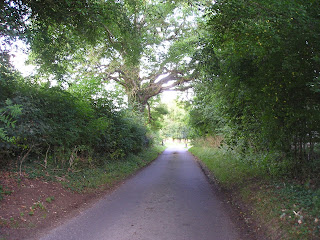An Ancient Craft - Flint Knapping
The very earliest tools known to man were made of flint or antler and in the Chiltern Hills, where I was brought up and lived for most of my life, it wasn't that unusual to dig up stone scrapers or even an occasional arrowhead, perhaps 4000 years old or more. One scraper that I found many years ago is shaped perfectly to fit between the thumb and forefinger and still has an edge so sharp that it cuts card.
To create these tools, the flints had to be chiselled or 'knapped', a technique that requires hitting the stone at an oblique angle with another hard object - such as another stone - to make it flake. With the coming of the Iron Age, the need for stone tools was no longer required but the skill did not die out and even today there is a requirement for the finished material.
Flint, a type of quartz, is extremely hard and durable and, being found in quantity in the chalk hills of the Chilterns, was the natural material for housing there. All types of properties used it from the humblest cottage to larger homes and churches.
One of the finest flint built villages can be found at Turville. If the two photos below look familiar this is because they feature in the comedy television series, The Vicar of Dibley with actress Dawn French, playing the part of the Revd. Geraldine Grainger. The village also featured in the 1998 film Goodnight Mr Tom, starring John Thaw. The church dates back to the twelfth century.
In the hills of the Cotswolds, the honey coloured limestone is the premier building material for almost everything but is especially well-known for its use in the dry stone field walls and village houses. At Stow-on-the-Wold in the centre of the region is the building below, once the office of the local brewery. It is rare to find flint used in the area and, as can be seen, it has been used decoratively, something that is not found to my knowledge in the Chilterns.
Although all of these images show properties that date back at least 150 years or more, flint continues to be occasionally used in modern housing and was even used as embankment supports on the M40 motorway when it was widened in the Chilterns a few years ago. As found throughout the centuries, when digging through the chalk, it proves to be the cheapest and most readily sourced building stone.
To find out more about flint knapping or to book a course to learn the art visit www.flintknapping.co.uk . It is worth looking at just to hear the magical sound of primitive flutes made from elder tree stems.

To create these tools, the flints had to be chiselled or 'knapped', a technique that requires hitting the stone at an oblique angle with another hard object - such as another stone - to make it flake. With the coming of the Iron Age, the need for stone tools was no longer required but the skill did not die out and even today there is a requirement for the finished material.
Flint, a type of quartz, is extremely hard and durable and, being found in quantity in the chalk hills of the Chilterns, was the natural material for housing there. All types of properties used it from the humblest cottage to larger homes and churches.
One of the finest flint built villages can be found at Turville. If the two photos below look familiar this is because they feature in the comedy television series, The Vicar of Dibley with actress Dawn French, playing the part of the Revd. Geraldine Grainger. The village also featured in the 1998 film Goodnight Mr Tom, starring John Thaw. The church dates back to the twelfth century.
Although all of these images show properties that date back at least 150 years or more, flint continues to be occasionally used in modern housing and was even used as embankment supports on the M40 motorway when it was widened in the Chilterns a few years ago. As found throughout the centuries, when digging through the chalk, it proves to be the cheapest and most readily sourced building stone.
To find out more about flint knapping or to book a course to learn the art visit www.flintknapping.co.uk . It is worth looking at just to hear the magical sound of primitive flutes made from elder tree stems.






If only I had know back when I lived in England, what I know now......boy would I have done so much more than I ever did then. I would be looking for things and exploring more. To find an arrowhead, made of flint in England is just different to finding one here isn;t it.
ReplyDeleteThe older we get the more interested we become in things. Sadly, there are never enough hours in the day...
ReplyDelete